Planning a visit to Isle of Arran in Scotland? In this segment of The Scotland Diaries, Anne Gavin shares the top 6 things to do on Arran.
I started off my month-long trip to Scotland this year returning to a familiar and much loved Scottish island — the Isle of Arran. It would be my third trip to Arran since 2017. The island holds many happy memories for me and some painful ones, too. My first trip to Arran involved a long, arduous yet personally enlightening walk along the 65 miles of the island’s varied coastline on the Arran Coastal Way. The walk was exhilarating, breathtaking, physically challenging but, ultimately, a personal growth opportunity that I still frequently reflect back on to this day. It cemented a number of friendships with some dear Scottish pals and sealed a life-long bond with an American friend who I met on my first trip to Scotland in 2016. Those six days of, at times, lonely walking up to 16-18 miles per day, seared Arran and all its magic into my soul. In many ways, it was a turning point for how I feel about Scotland and my place there.
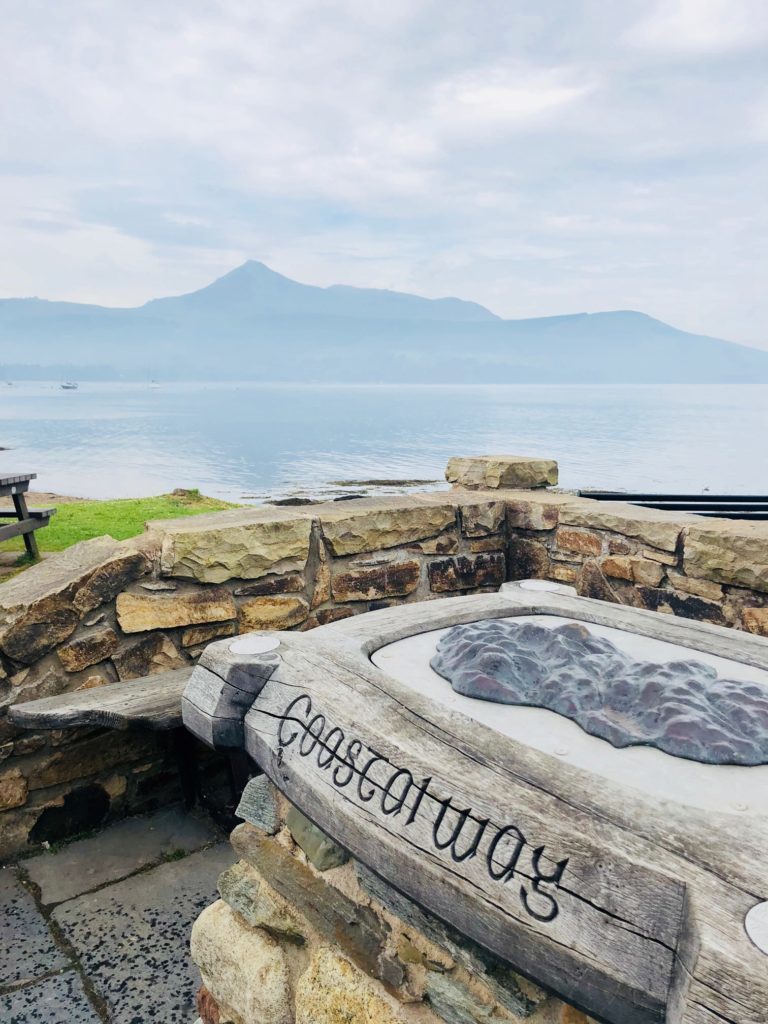
In 2018, I returned with a very special Scottish friend. It was a just a day trip, but those few hours spent walking the beach in Brodick, dodging some rain showers and, ultimately, enjoying the last of the Scottish summer in the shadow of Brodick Castle whilst exploring its beautiful gardens, also remains a special memory for me.
However, I wasn’t done with Arran yet. It always calls me back. So, when plans were being made for Scotland 2019, I felt the pull to go back to Arran and tick several things off my list that I had yet to see and experience due to the rigorous walking schedule in 2017 and time limitations of our day trip in 2018. With only four days to spend before we headed out for more adventures in Scotland, we had to make the most of our time. However, the beauty of Arran is that it’s very easy to get to from Scotland’s west coast via CalMac ferry and once there, the island is easily navigable. But, for purposes of this first dispatch of “The Scotland Diaries 2019,” I thought it would be useful to give a list of the top six things you could reasonably accomplish in just four days. You’ll need to be on the move, but Arran is most definitely worth it. So, here we go…
#1 Visit the Holy Isle
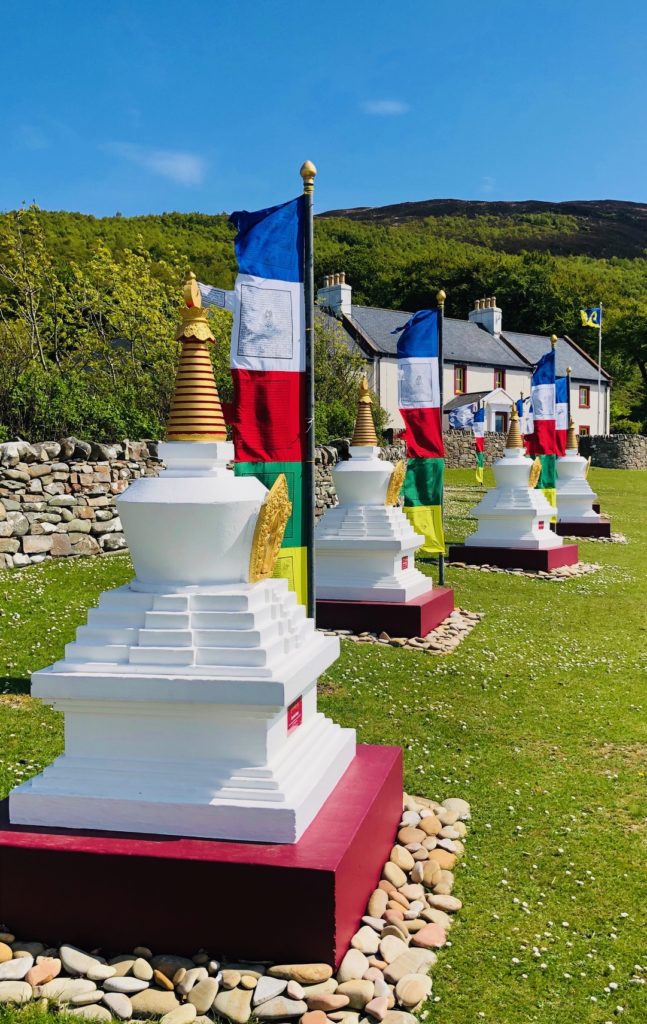
Some of the Buddhist monuments that greeted us on Holy Isle
If you are up for an unusual adventure – and I always am – then take the time to make the trip over to the Holy Isle. Holy Isle is located just 15 minutes by boat from the village of Lamlash on the southwest coast of the island of Arran. Holy Isle has a long history as a sacred site, with a spring or holy well held to have healing properties, the hermit cave of 6th century monk St. Molaise, and evidence of a 13th-century monastery. An old Gaelic name for the island was Eilean MoLaise, Molaise’s Island; this is the origin (via Elmolaise and Limolas) of “Lamlash,” the name of the village on Arran that faces Holy Island. The small, no frills Holy Isle Ferry leaves each morning at staggered times. It’s recommended you phone in advance to secure your spot and be aware that crossings are dependent on tides and weather.
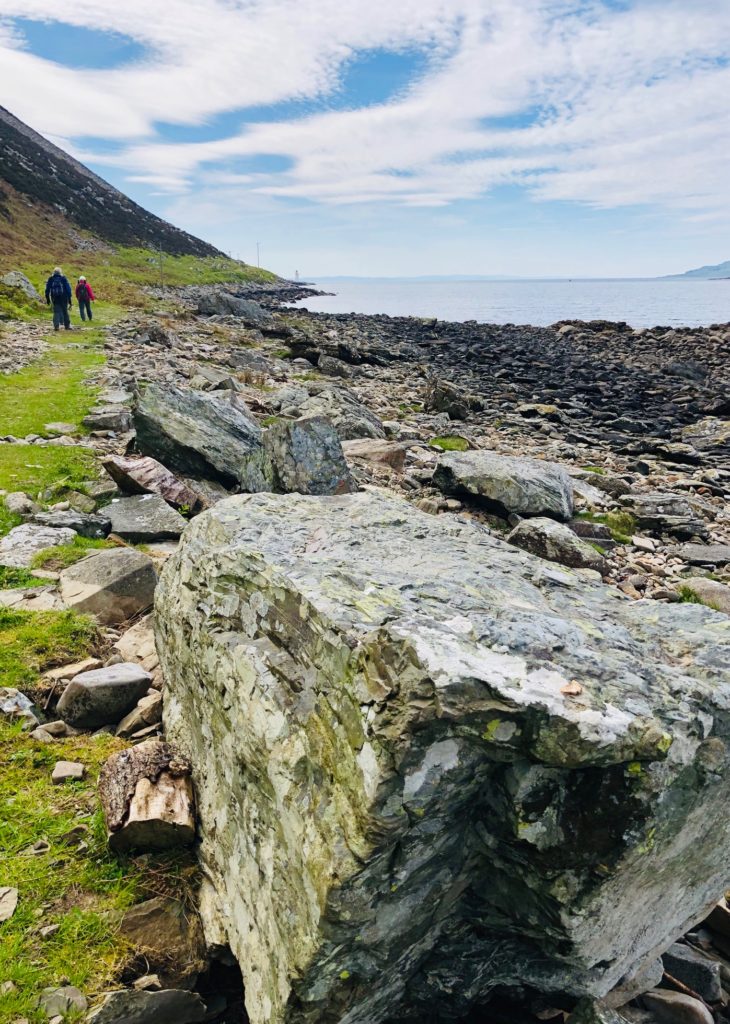
Shore path on Holy Isle
It was a gloriously sunny day when we started off. Upon disembarking from the ferry, we were met by a representative of the Buddhist Community who resides there. The representative gave us a brief orientation to the various trails we could take either around or up the island to the summit. We opted for the shore route, which was well carved and very scenic, especially on this beautiful, sunny and warm day. Present day Holy Isle is now owned by the Samyé Ling Buddhist Community, who belong to the Kagyu school of Tibetan Buddhism. The main settlement on the island is the Centre for World Peace and Health, on the north of the island. This is an environmentally designed residential centre for courses and retreats. There is also a very isolated second Retreat Center on the south side of the island.
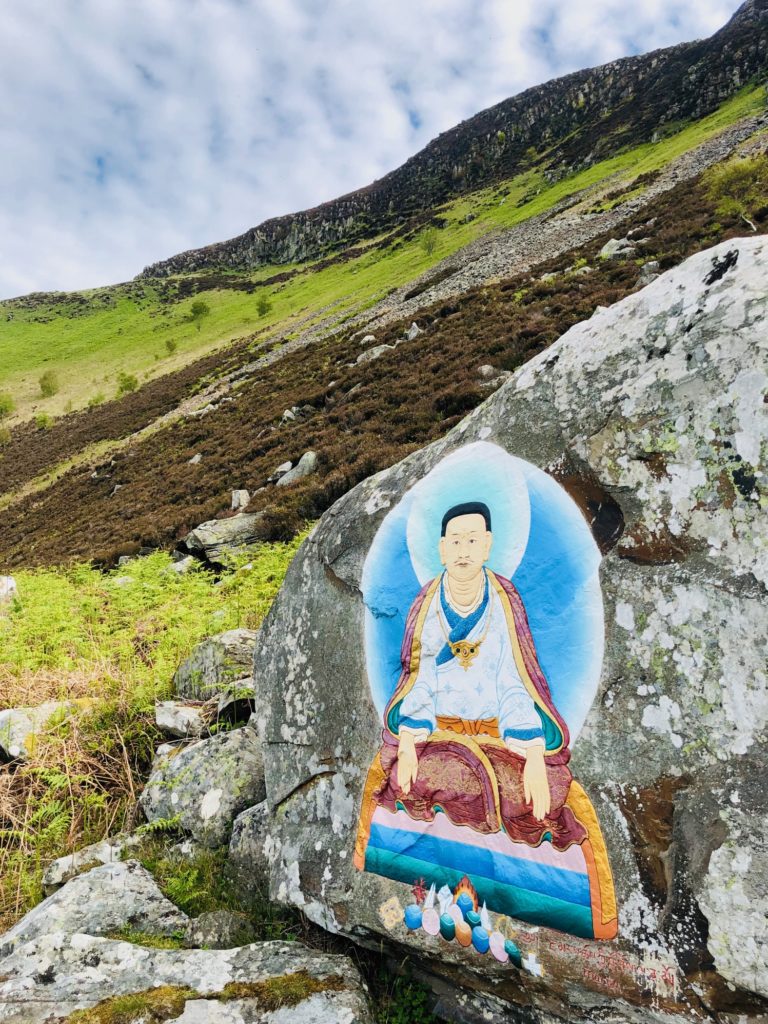
As we walked, we came across several rock paintings along the shoreline path. The paintings depict the Buddha and several Tibetan Buddhist icons. We also were fortunate to share our path with many of the island’s feral animals, including Eriskay ponies, Saanen goats and Soay sheep. As is the case with wild things, the animals were not particularly friendly but they certainly didn’t mind having their photo taken!
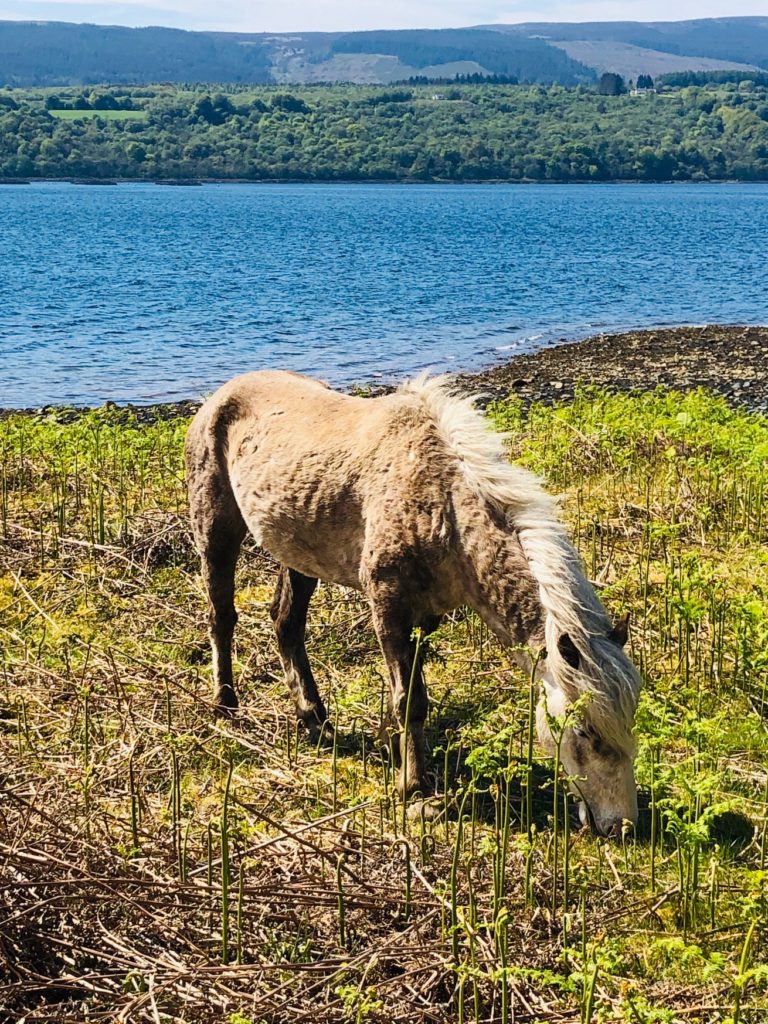
Wild Eriskay pony
We passed the very isolated second Retreat Center – hidden away down a path and near one of the island’s two lighthouses. There was an Honour Cart at the top of the path where you could flip through and pull out small bags of teas, seeds or herbs, which we did. Unique little gifts for some of our gardening friends and family.
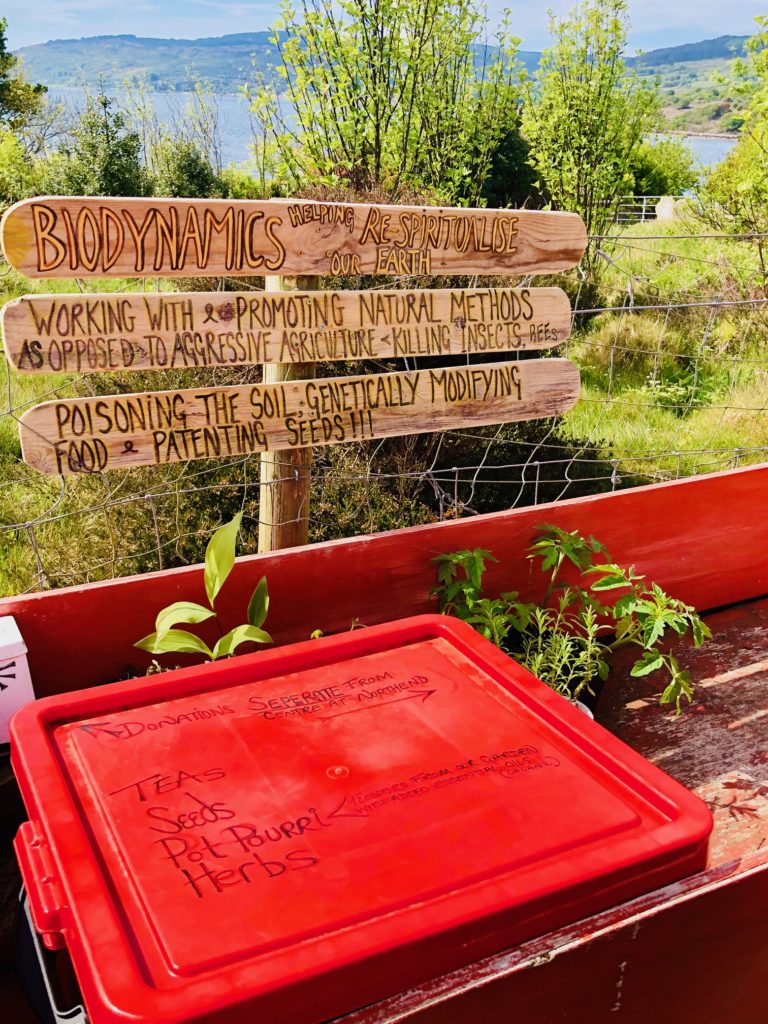
Honour Cart!
We walked the shoreline route to the end, including up a rather steep hill but were rewarded with great views of Pillar Rock Lighthouse and across the Firth of Clyde. We took our time walking out and back but made our return to the jetty in time for a late afternoon ride back to Lamlash for coffee and cake at the tea house across from the dock. Tides delayed our departure from the island, but we had a laugh with a number of other island-goers who had taken a different route from us and were also lamenting the lack of coffee or food facilities on the island. WalkHighlands is great for planning your walking route whilst on Holy Isle. Next time we will attempt the summit route for all the views! Overall, it was a fun-filled day out and another truly unique Scottish experience punctuated by gorgeous sun, blue skies and great company! Holy Isle is a definite must-do when visiting Arran.
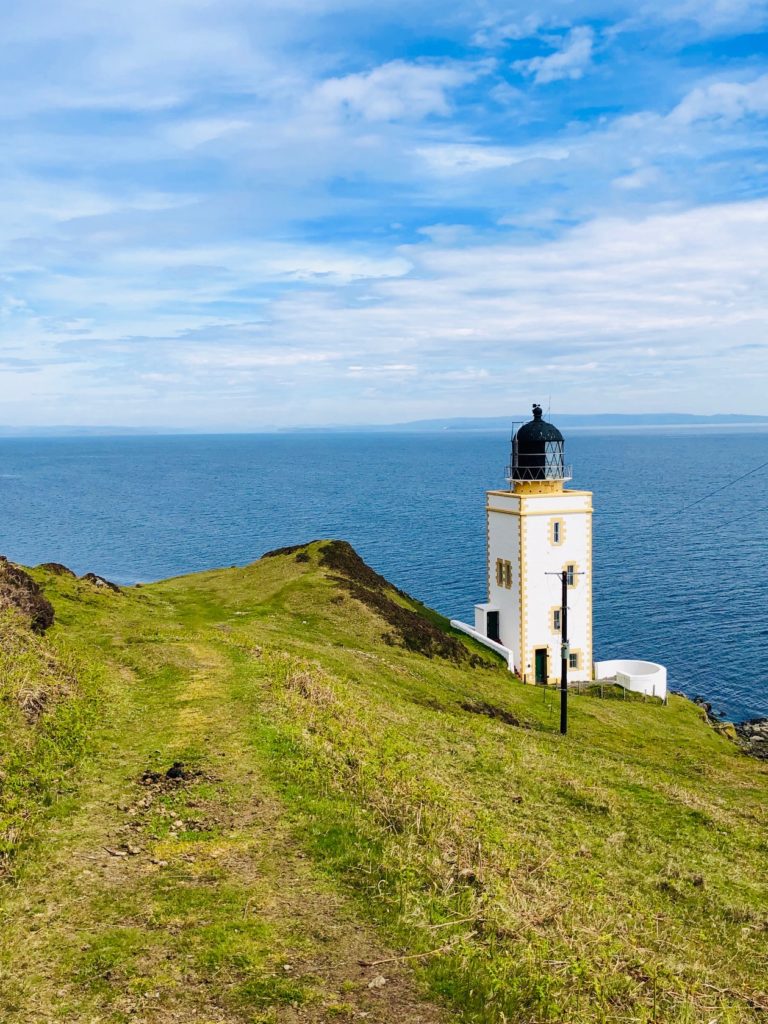
Pillar Rock Lighthouse and the Firth of Clyde
#2 Machrie Moor Stone Circles
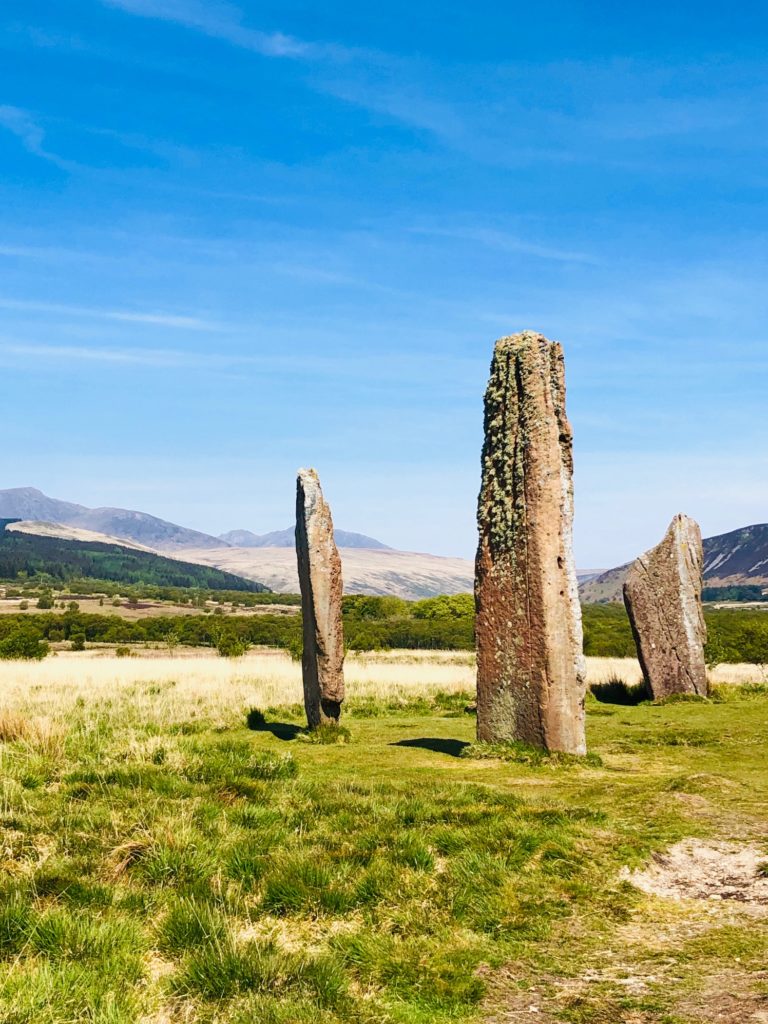
Hard to believe that in my last two visits to Arran, I had yet to make the trek to the Machrie Moor stone circles. But, it’s true! I walked on by in 2017 on our Arran Coastal Way hike and our day trip in 2018 didn’t allow for any time to travel to the other side of the island. It is a bit of a drive from the more densely populated side of the island where we were staying – Brodick – to just beyond Blackwaterfoot on the A841 south of the bridge over the Machrie Water. Once parked, it is, in fact, a trek to get to the stones. From the very small car park, it’s approximately three miles by foot to the main stones. There is a well-defined, mostly flat track through farmlands and past a smaller stone circle, not to be confused with the Machrie Moor circles up ahead. Once we came across that first circle, we had a bit of a “is this it?” moment. But, pressing on, the track begins to undulate some until you come across the ruins of a fairly large farmhouse to the left. Despite the pull to explore the ruins, we pressed on anxious to get to the main attraction. Before doing so, you come across the double stone circle known as the Suide Choir Fhionn or Fingal’s Cauldron Seat, named after the legendary warrior and giant Fingal.
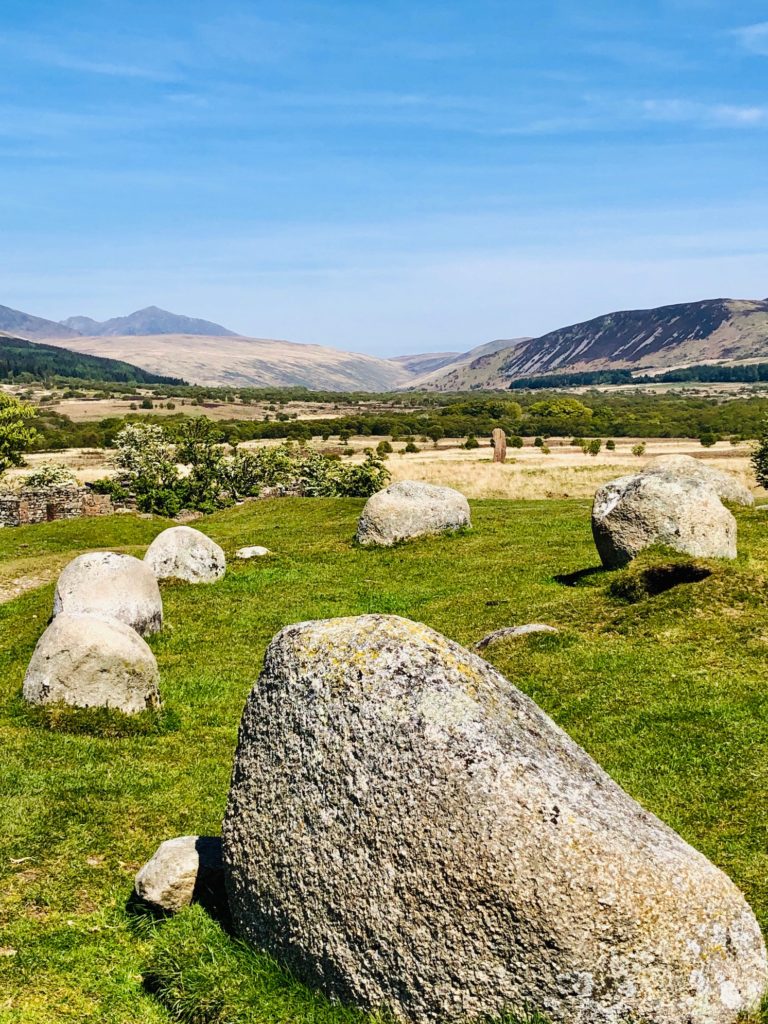
Suide Choir Fhionn/Fingal’s Cauldron Seat
The first thing that struck me was the vastness of the area upon which not one stone circle sat, but several including one lone solitary stone. Machrie Moor is actually a large complex of stone circles, standing stones, cairns and hut circles, which makes it one of the most interesting and remarkable archaeological sites in Scotland. Honestly, I had no idea it was this big — multiple stone circles across the moor. Six circles are visible. Some circles are formed of granite boulders, while others are built of tall, red sandstone pillars. The moor is covered with other prehistoric remains, burial cairns and cists. Several hut circles can also be seen as low rings of turf-covered stone.
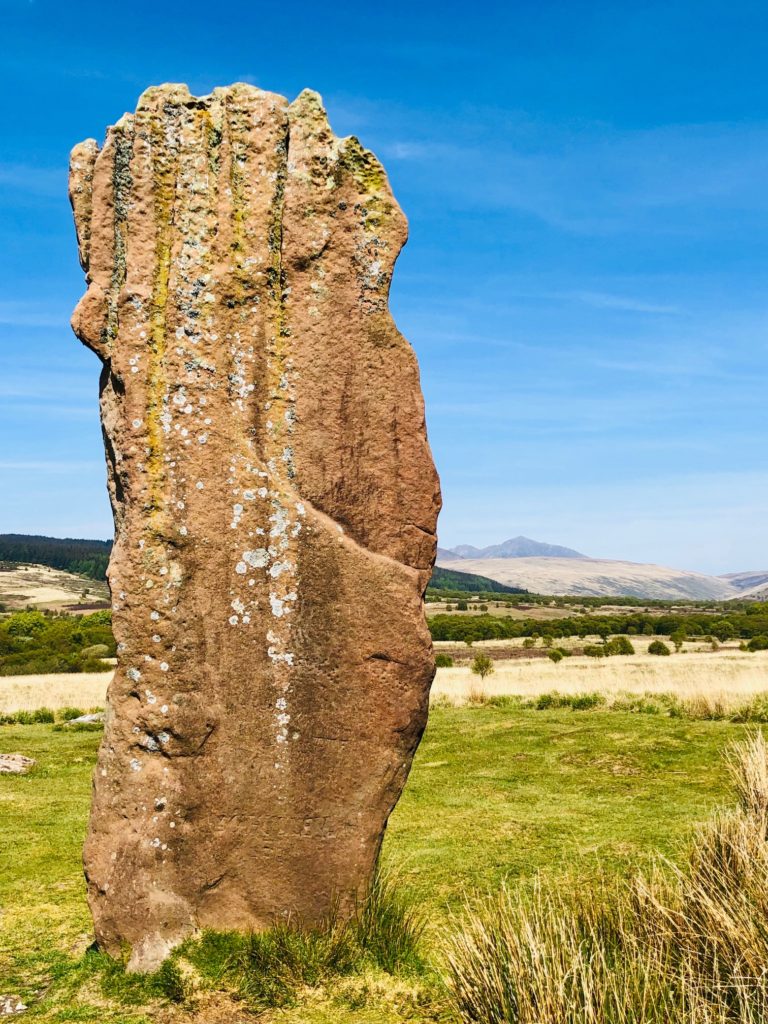
The moor itself is desolate but with crystal clear views of Glen Rosa and Goat Fell in the distance this day, which made the moments there even more magical and framed up some pretty special photo opportunities. It took me a while to get there but Machrie Moor quickly became one of my favorite stone circles I had seen in all my travels through Scotland. There is something about the desolation of the moor and the sense of wonderment as to how these stones were transported to this remote place. Add that to the magnificence of Arran’s highlands in the distance and you feel quite transformed. Oh, ancient people, why and how did you build these structures? I don’t think we will ever know the answer, which only adds to the ambiance of this stunning place. I tried touching the stones — not to see if I could time travel(!) — but to try to absorb some of the magic of this place. I think I might have been successful! The walk to the Machrie Stones needs to be on everyone’s Arran list!
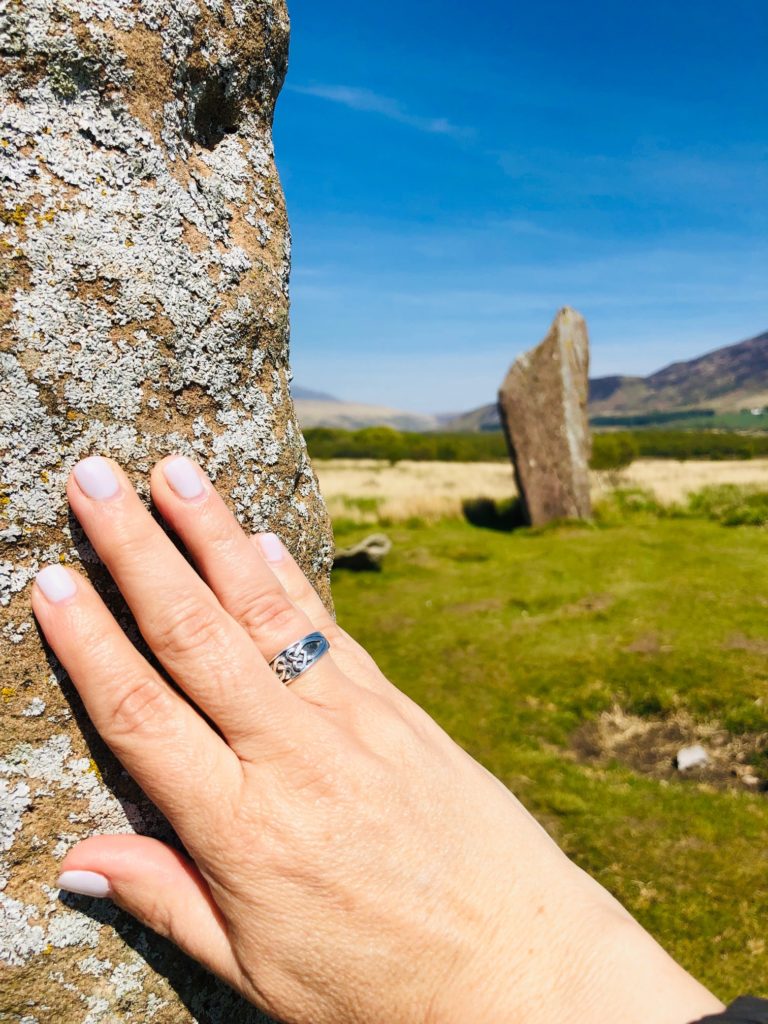
#3 Castle Hunting
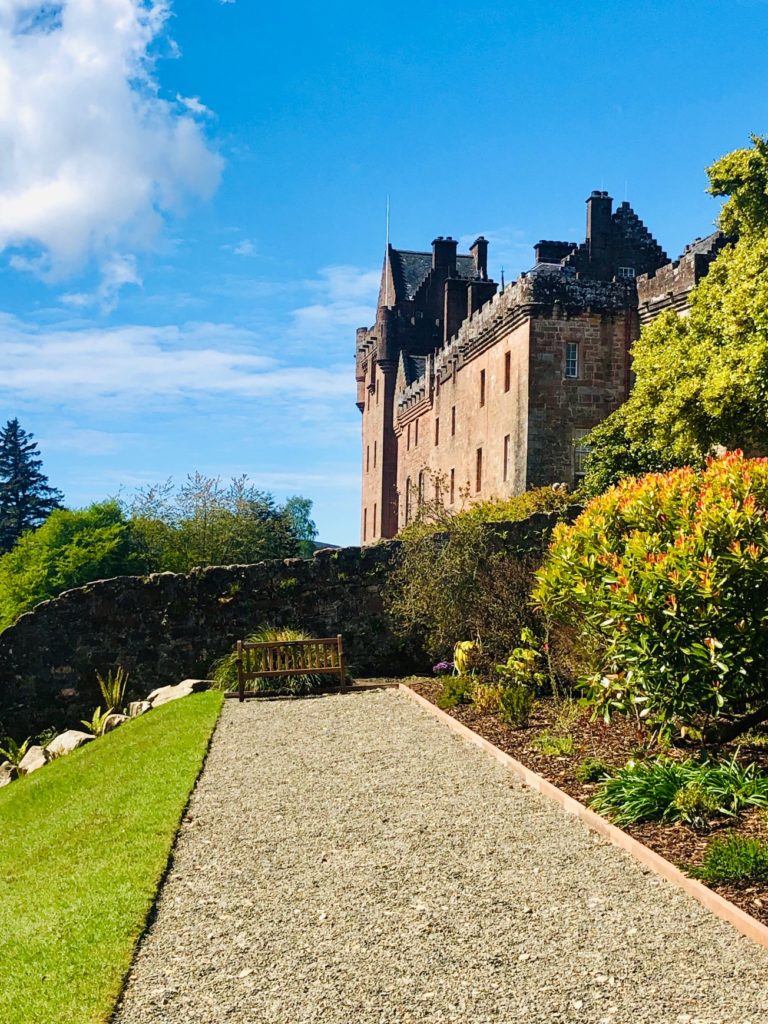
Brodick Castle & Gardens
The Isle of Arran is often referred to as “Scotland in Miniature.” It is a microcosm of Scotland as a whole with Arran embodying the nation’s wide variety of landscapes, including highlands, lowlands and craggy island coastlines. But, what is Scotland without castles? Indeed, Arran has three distinct castles to explore, any one of which is worth the effort to get there.
Upon arriving on Arran in 2017, one of the first parts of the Arran Coastal Way we walked included a segment from the ferry terminal along to Brodick Castle, which sits majestically on a hill above Brodick Bay. The Castle grounds are glorious especially in the spring when the gardens situated below the castle are in full bloom. But, in 2017 the castle, owned by the National Trust for Scotland, began an extensive renovation of the castle interiors. For two years, the interiors remained closed. This happened to correspond with the two years I had visited Arran previously. But, in 2019 the castle was scheduled to re-open in the early spring and I was very excited to finally see the newly refurbished interiors of this grand baronial style castle.
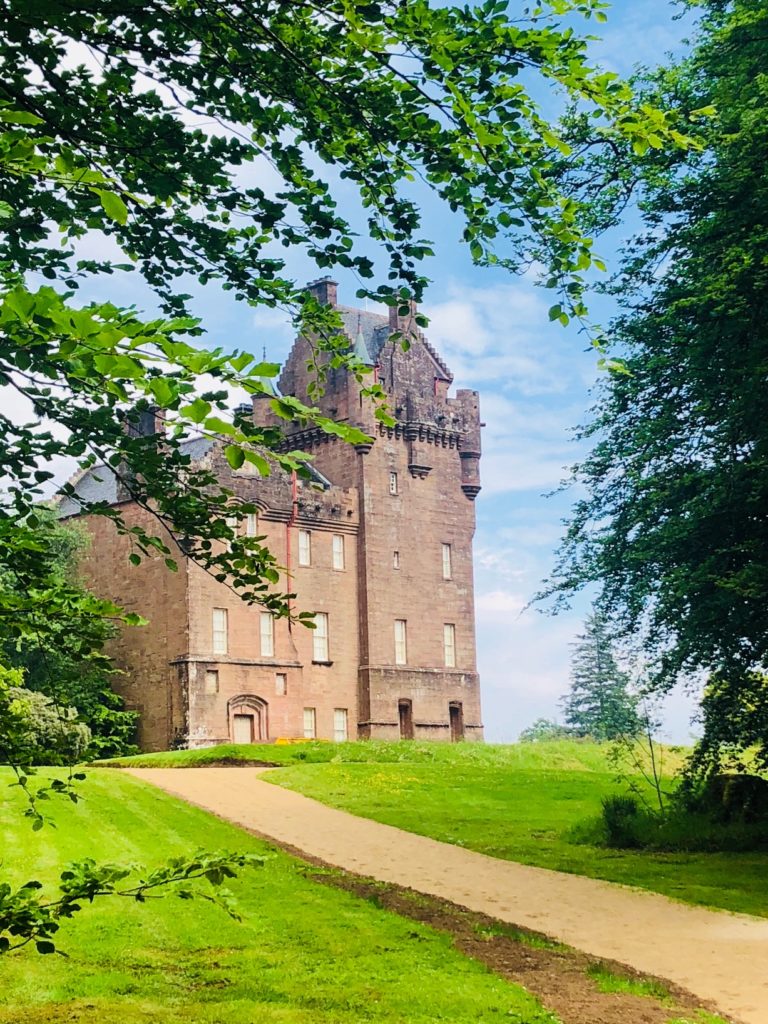
A fortress has existed on the site of the castle since at least the fifth century. It was believed to be once under the control of the King of Norway due to the number of Scandinavian place names on the island, including Brodick, or Breiðvík (Broad Bay). The site is thought to have been a centre of relative importance because of its strategic position on the Firth of Clyde. Brodick Castle fell victim to the back and forth of medieval rivalries and fell in and out of English and Scottish hands multiple times over the centuries. Eventually the Castle became the seat of the Hamilton family and the present structure we see today was constructed in the mid-1800s for the 11th Duke of Hamilton and his bride Marie of Baden. The castle and gardens were passed to the National Trust for Scotland in 1958.
We were thrilled to see the extensive collection of artifacts from the time period of the 11th Duke and his glamorous wife inside the castle rooms. The interior collection includes period furniture, silverware, porcelain, paintings and sporting trophies. An interesting new addition is an interactive visitor experience that focuses on the stories of the people who once made the castle home, including activities that bring the building to life. We met a few period actors wandering about who were eager to tell us stories of the Hamiltons and their exploits.
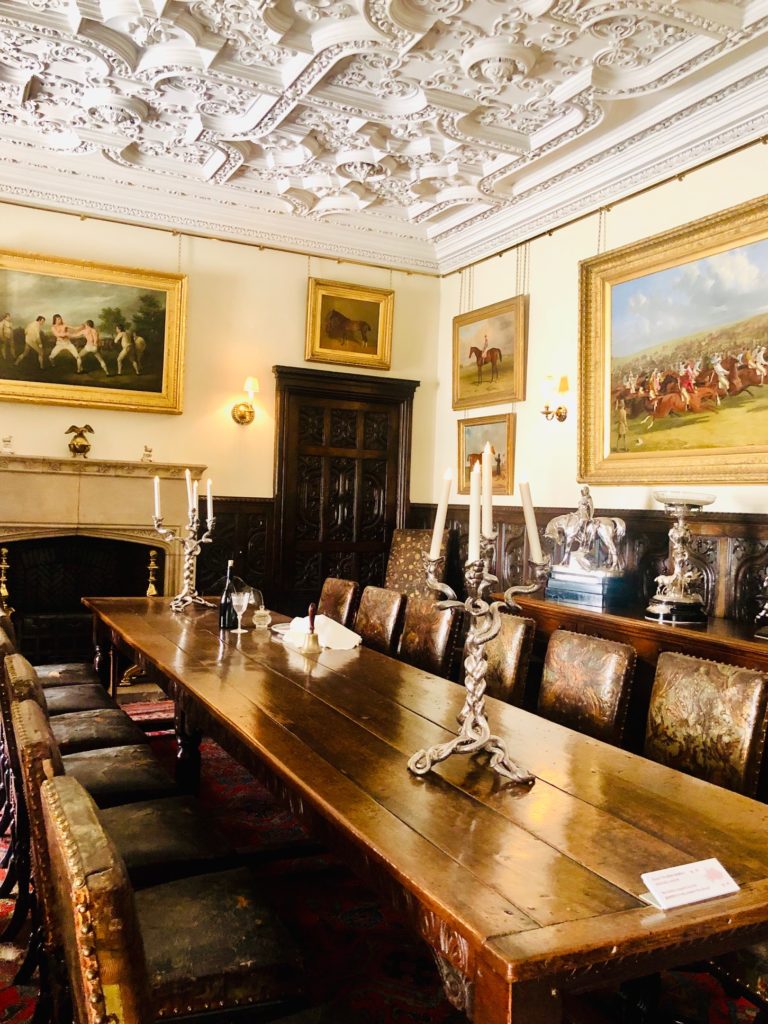

credit: Gary Dempster Photography
It was a thrill to finally have the chance to walk through the castle after wondering what was inside for so long. And, after hearing talk on the tour of a “family cemetery” not far up the hill from the castle, we set off in search of it because, well – graveyards! It was a bit of a let down especially after scrambling up what seemed like half the route up Goat Fell – the island’s tallest peak. The graveyard was not very impressive and not well sign marked either. However, it was a good hike nonetheless. Brodick Castle is the most intact castle on Arran, but it was an up-close look at Lochranza Castle on the opposite side of the island that I was most looking forward to seeing.

Lochranza Castle
One afternoon, we packed two cars full of the houseful of reprobates I had along with me – five Scots and three Americans. We made the drive over to Lochranza Castle. In 2017, I had only seen the castle from across the bay as we completed the third leg of our Arran Coastal Way walk. It had been a 12-mile day over rough terrain so no one was interested in sightseeing at the castle as we limped to our end point. But, this trip I was determined to get there for a closer look at these medieval ruins.
The castle sits out on a spit of land at the entrance to a small bay on which one side is the very diminutive village of Lochranza. The castle had its beginning in the 12th and 13th centuries as a hall-style house comprising a two-story, oblong building with storage on the ground floor and a hall and private chambers above. Excavations in the 1950s discovered that it’s likely the castle was remodeled in the 16th century to the more traditional L-shaped Tower House that we see today. It is believed that Robert the Bruce landed at Lochranza in 1306 on his return from Ireland to claim the Scottish throne. By 1371, the castle was the property of Bruce’s grandson, Robert II, and was used as a royal hunting lodge. Not content with just the sumptuous Brodick Castle, the Hamilton family purchased Lochranza in the early 1700s. It was later sold again but fell into disrepair and was abandoned in the late 1800s. Historic Scotland now manages the property.
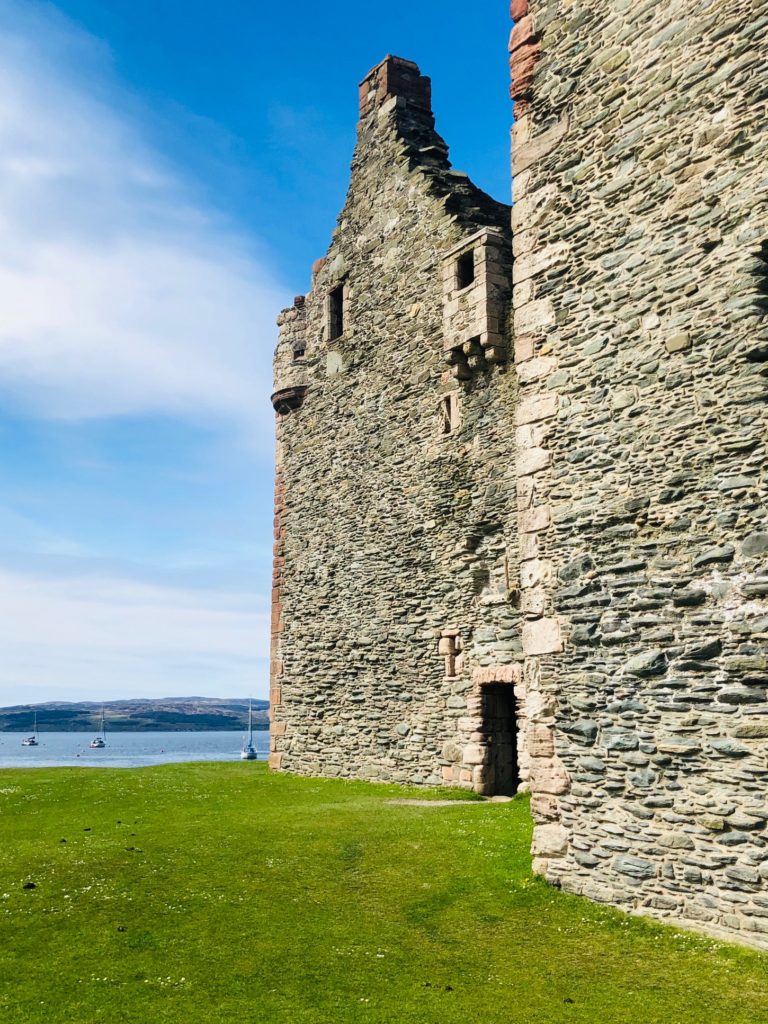
It’s actually hard to make out much of the ruins at Lochranza. The castle interiors are badly damaged although the exterior edifice remains imposing. I found myself most impressed with the position the castle occupies on the small promontory of land that juts out into the bay. There are beautiful views from all sides – the mountains of Glen Rosa to the rear and the Sound of Bute to the front. The lack of definition of the interior ruins, however, makes it that much more fun to imagine the castle in its hay day. It was a blustery day when we visited, but we enjoyed our wander around the castle and the sound of the wind and the waves. We punctuated our visit with a few windy wee selfies in front of the castle. Lochranza’s charm lies in its beautiful, picturesque setting. We were fortunate to visit on a sunny day when the castle can be seen in its best light.

The Clarks of Kilmarnock and me
Last but not least, quirky Kildonan Castle lies in the small village of Kildonan on the southern coast of Arran. The castle’s name is derived from the name of a former resident, Irish monk Saint Donan, who is said to be buried on the island. I have made two trips to Kildonan and am astonished each time that what remains of the castle manages to remain standing. You have to park about a quarter mile away and then walk down a dirt road to the castle. Don’t miss the “Wee Gallery,” which you will pass just before arriving at the castle ruins. The remaining tower of Kildonan Castle literally teeters on the edge of a rocky plateau above one of Arran’s few sandy beaches. You can see the small islands of Pladda and Ailsa Craig in the distance on most days from the castle. The castle ruins are covered in green ivy making it hard to even discern its stone skeleton.
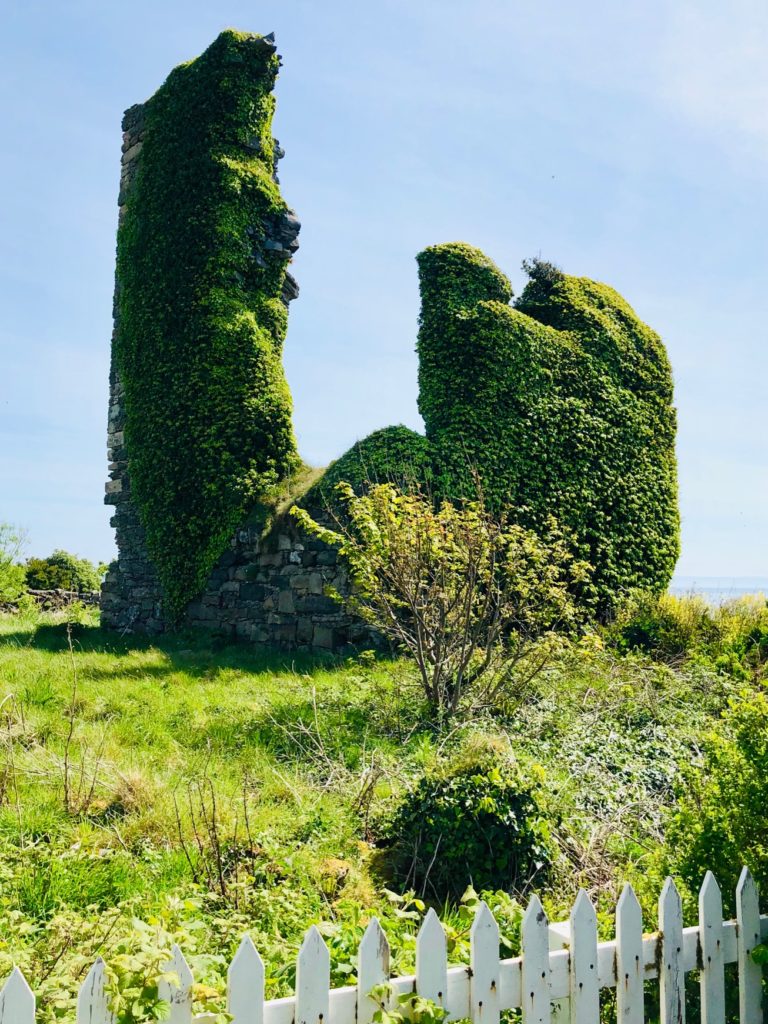
Quirky Kildonan Castle
Due to its strategic location, the castle was used as a fortification as early as the 13th century. As with the other two castle fortifications on the island, it passed back and forth between clans – mainly the Stewarts and the MacDonalds. But, eventually landed with the Hamiltons once again. Today the castle is the backdrop to a private cottage garden and is overlooked by vacation rentals – truly a unique setting for a holiday cottage. There is a picket fence around the castle so what little remains of the interiors are not easily accessible. If you do try to access, take heed not to wander far. The cliff itself appears quite unstable. It’s altogether a very peculiar little castle that somehow has stood the test of time. I fear, eventually, however, the castle will be lost to erosion and the sea, perhaps sooner than we think.
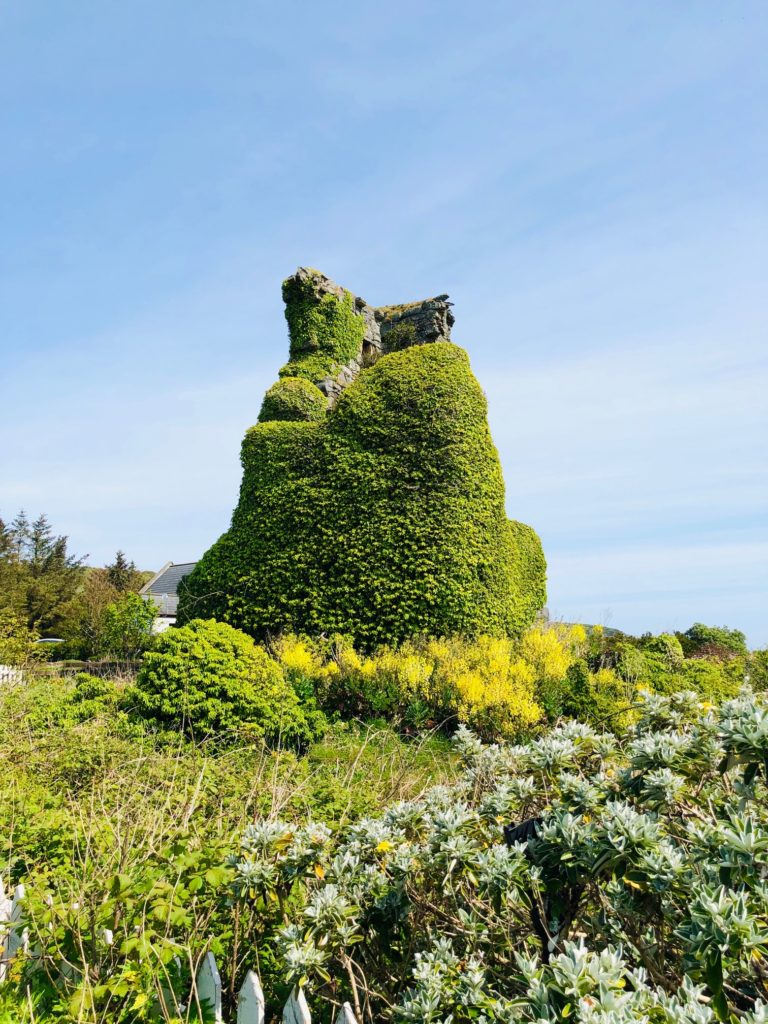
Arran offers several opportunities for castle explorations or you can try to visit all three – definitely doable in an afternoon. It’s not Scotland if you aren’t hunting castles!
#4 Hike Goat Fell
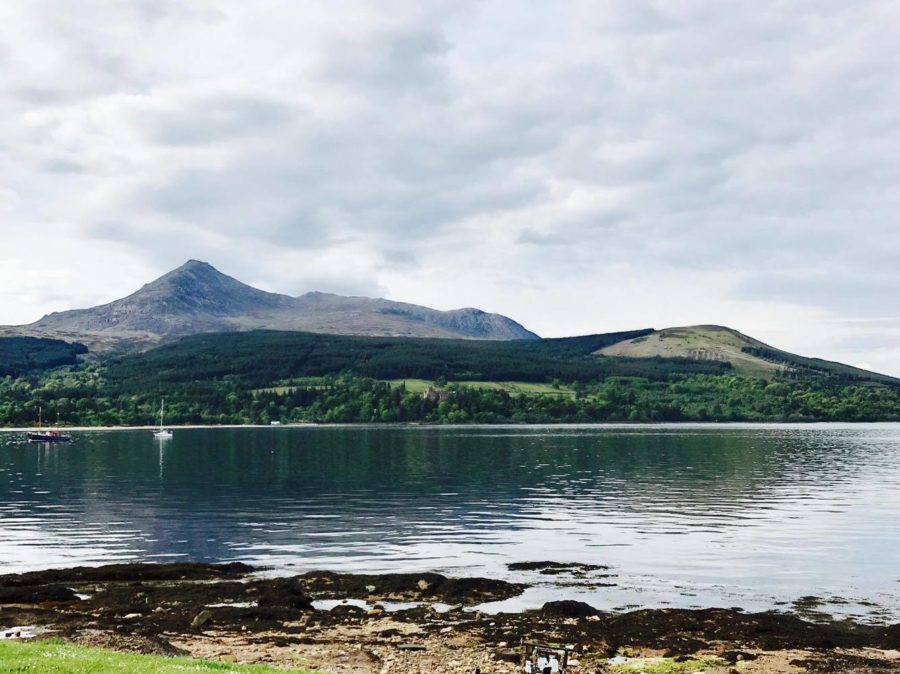
Arran’s topography is dominated by a very distinctive looking peak — Goat Fell. It is the island’s tallest mountain and one of four Corbetts on Arran, which are peaks that are between 2,500 and 3,000 feet. Goat Fell is just shy of Munro status, rising 2,867 feet above sea level. Goat Fell’s unmistakable pyramid profile dominates almost all images of the island. It’s a popular climb for visitors and worth every craggy step for the views at the summit. A hike up Goat Fell makes my list because it is doable in a half day depending on your route and feasible for even the novice hill walker. That said, Goat Fell is not a peak to be taken lightly. I hiked Goat Fell for the first time in 2017 as part of our Arran Coastal Way trek. It’s an add-on to the coastal route and very hard to pass up especially on a clear day. The most common route to ascend is from the trail head next to Brodick Castle. There is a well-marked gravel path that leads up through the forests surrounding the castle grounds. Once leaving the forests, the trail continues through heather moorland with the occasional stream and waterfall.
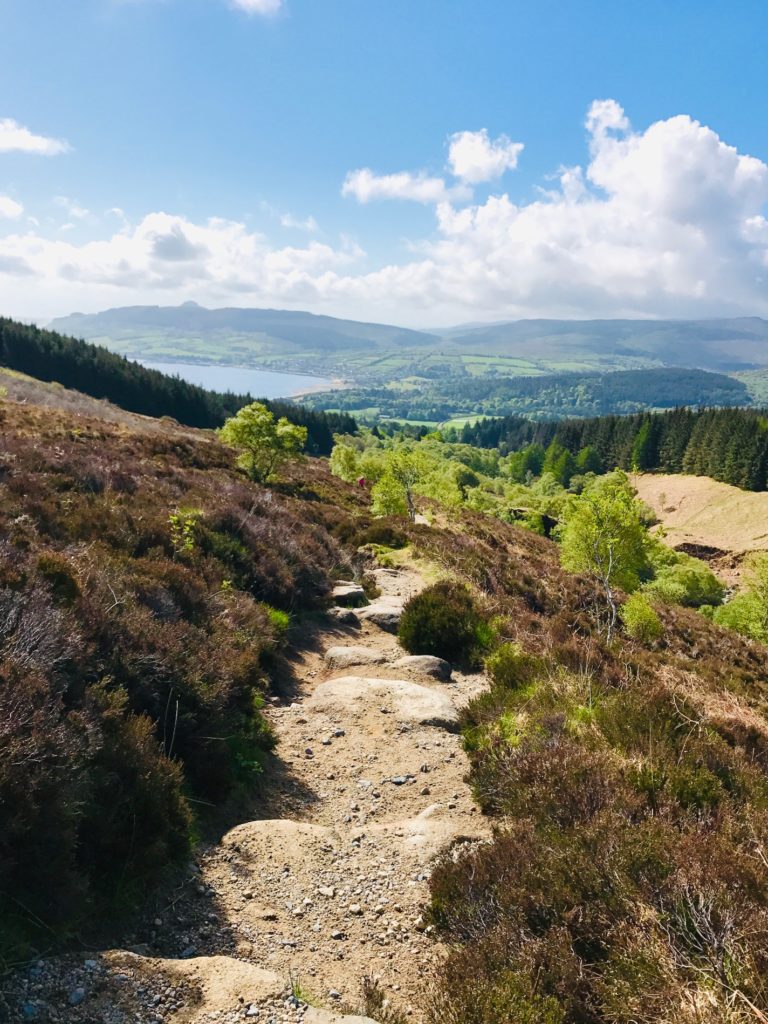
Mid-way up Goat Fell
Just below the summit is a granite boulder field that seems never ending. Heart, lungs and knees are tested as the summit draws near. The boulder scramble prior to the summit is the hardest part of the ascent, but by that time you’ve gone too far to give up. I’ll never forget the variety of weather we experienced on that climb. We started off in t-shirts and near 70F temperatures and ended with snow, sleet and 20-mile per hour wind gusts. I am not kidding! As with any hill walking in Scotland, you must be prepared for all kinds of weather. I would never have believed it to be true, but that day we truly did experience all four seasons on that mountain. As mentioned, views at the summit are truly other-worldly. Misty clouds drift lazily between the peaks of Glen Rosa down the north side of the island and on a clear day you can make out the Paps of Jura, Ben Lomond and even Northern Ireland. The panoramas are spectacular and provide a clear example of a landscape shaped by ancient glaciers.
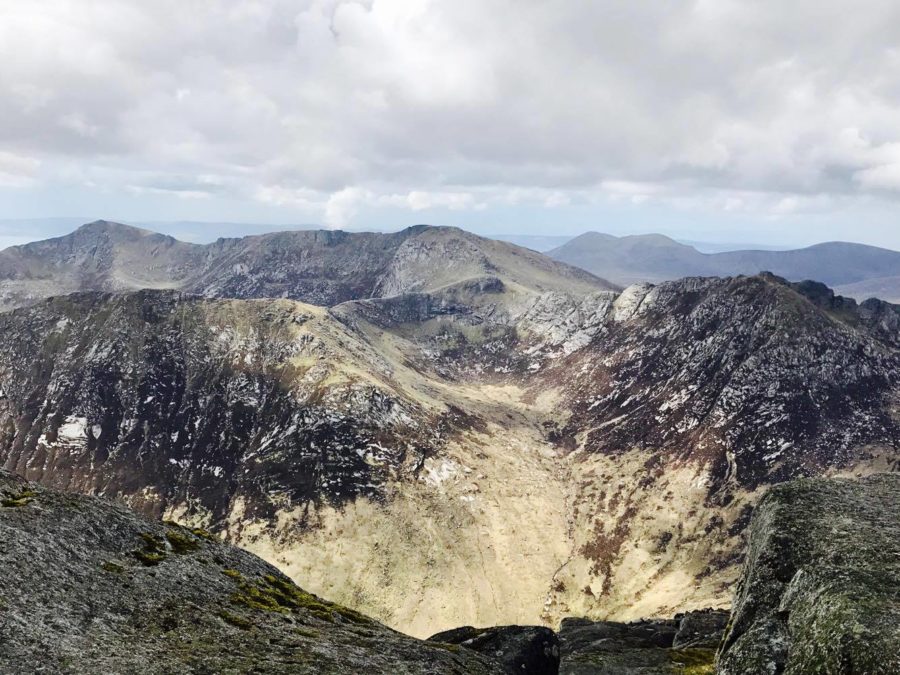
View from Goat Fell Summit
I confess to feeling a wee bit emotional upon reaching the summit that day. I was middle to back of the pack of my walking group and, at times, I felt exhausted. I never wanted to give up, but I did want that painful final ascent to end. We spent a good 45 minutes at the summit, which was full that day with happy walkers – a bit of a party atmosphere. It was just what I needed – that and the views – to face the descent, which most hill walkers know can be worse than the climb. The easiest descent is back the way you came. That day, we returned along the north ridge, known as the Corrie route. The route was dominated by rocky footpaths, very steep terrain with more than a little boulder scrambling in places. There was a minor mutiny when we finally reached the road near Corrie and were told by our hike leader that we still had a mile or two of road walking left. The mutiny, however, proved successful and not long after we reached the road our road crew picked us up.

It was a long, hard and, at times, painful day. But I look back on that day now and feel so grateful for the beautiful weather, the camaraderie of my group as well as the pride of personal achievement. And, while I may not have thought it at the time, hiking Goat Fell is a must do when visiting Arran and easily makes this list!
#5 Drive (or bike!) the String Road
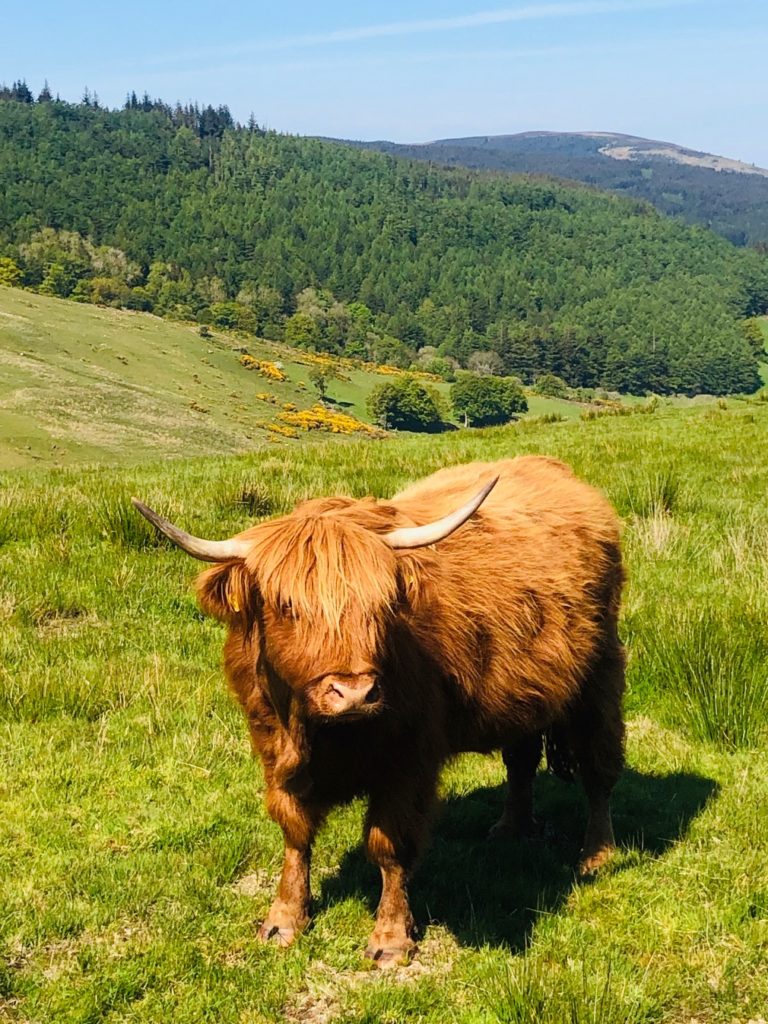
In 2017, we were so focused on our circular path around the island along the Coastal Way that I had no knowledge that, in fact, there were other ways to traverse the island. After all, it’s the coast views you usually seek out when visiting an island thereby necessitating you take the circular path. So, while there are many beautiful vistas when circumnavigating the island, an alternative exists that is also worth a drive. In 2019, my Scots friend had told me that a quicker way to the other side of the island was via the scenic String Road also known as the B880. You can pick up the String Road in Brodick (the west end) or Blackwaterfoot (the east end). The distance between is approximately 11 miles. The road essentially dissects the center of the island and gained its name because from the sea the road looks like a small string draped across the island. Road construction on Arran is relatively new – 19th century. In 1810, at the joint expense of the government and Arran landowners, a road suitable for wheeled traffic was constructed between Lamlash and Brodick. It was known as the “Parliamentary Road.” Seven years later, the road was continued from Brodick to Blackwaterfoot and became known as the “String Road.” The road was planned by famous Scottish road engineer, Thomas Telford. The Duke of Arran maintained the road at an annual cost of 80 pounds.
There are a number of chambered cairns and ancient mounds along the road although most require an archaeologist’s eye to spot. At the bottom of the southern part of the route, we stopped to take a snap at probably one of the fanciest and oddest looking letter boxes I had ever seen. The story goes that at one time the post box was painted white. One day the Laird’s daughter came riding by on her horse. The white box gave the horse a fright and presumably the Laird’s daughter fell from her horse. After this unfortunate incident, the Laird hired a stone mason from Ayrshire to build the striking carved replacement. So far no one has been able to make any meaning of the carved symbols on the post box. The box remains a famous landmark along the String Road and likely one of the most photographed.
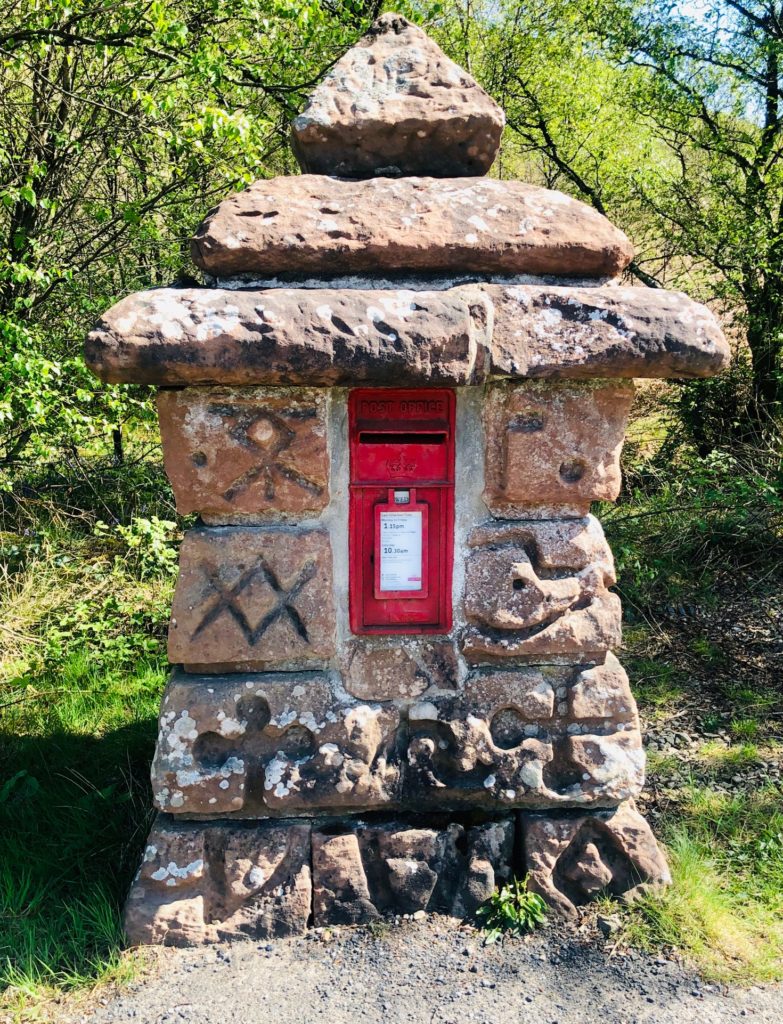
As you climb upwards along the String, you can look behind you and see the Machrie Moor below and just make out the stone circles there. But, it’s the climb down from the summit and views of the Glen Rosa that are truly striking. On a clear day, you can see right over to Ayrshire. There’s a lay-by for this viewpoint, so take a wide-angled lens with you to make the most of the stunning scenery! Along this stretch, the peak of Goat Fell rises so near you feel as if you can reach out and touch it. Lucky for us, there was also a herd of Heiland Coos along the side of the road just past the summit. They were posing for sure and we couldn’t resist a quick stop to snap their fabulous mugs.
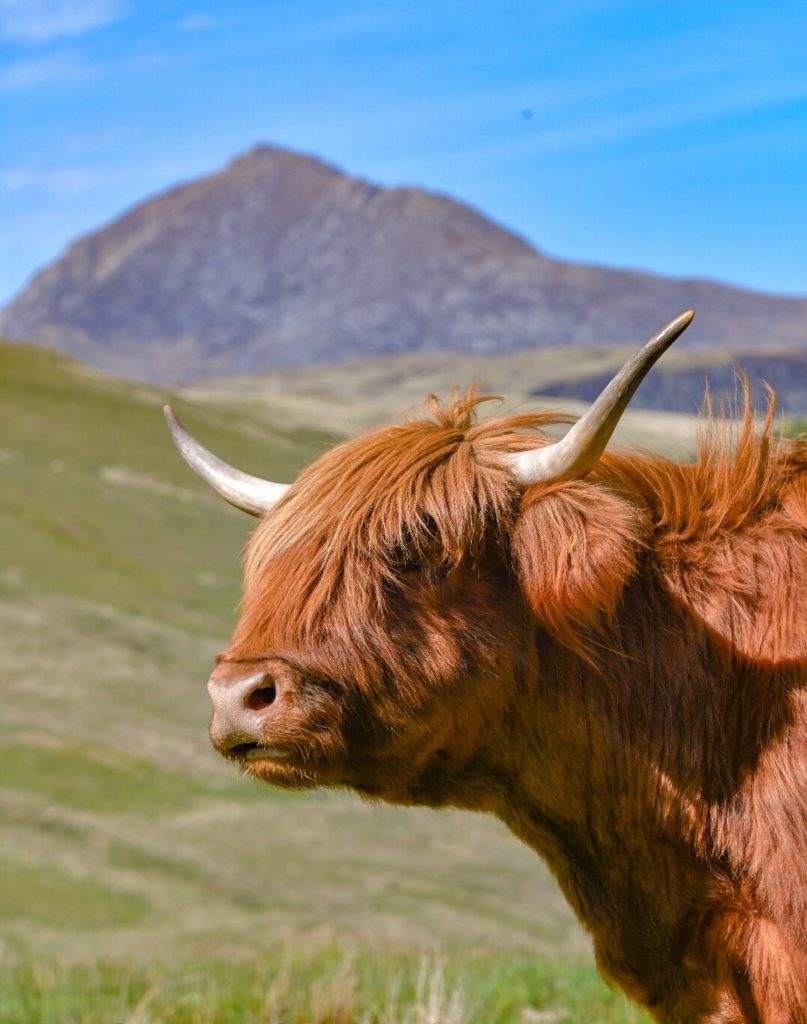
credit: Gary Dempster Photography
Another creature to keep an eye out for is the famous White Stag of Arran. Ancient Celtic mythology revered the White Stag as a creature of such rarity that it was seen as a messenger from the afterlife. Their appearance is said to herald some profound change in the lives of those who encounter them. There are one or more White Stag that live on Arran and some have been spotted near the String Road when they come down from the hills above Lochranza. The last known spotting of a White Stag was in 2017. It is said the Stag makes an appearance before a member of the Hamilton family passes away. Just a few days after the White Stag was see in 2017, Lady Jean, younger daughter of the 6th Duke of Montrose, and the last Hamilton to live in Brodick Castle, died. Unfortunately – or maybe fortunately for the Hamiltons – we didn’t see this mythical creature on the String Road that day. But we were looking!
A drive or bike ride along the String Road is a treat, particularly on a clear day when the views are there for the taking. It’s a scenic and easy way to traverse the island on your way to the Machrie Moor stones or for a pint at the Kinloch Hotel in Blackwaterfoot. Also, a great way to get to my next must-do activity particularly if you have an early tee time…
#6 Play a Round of Golf at Shiskine Links
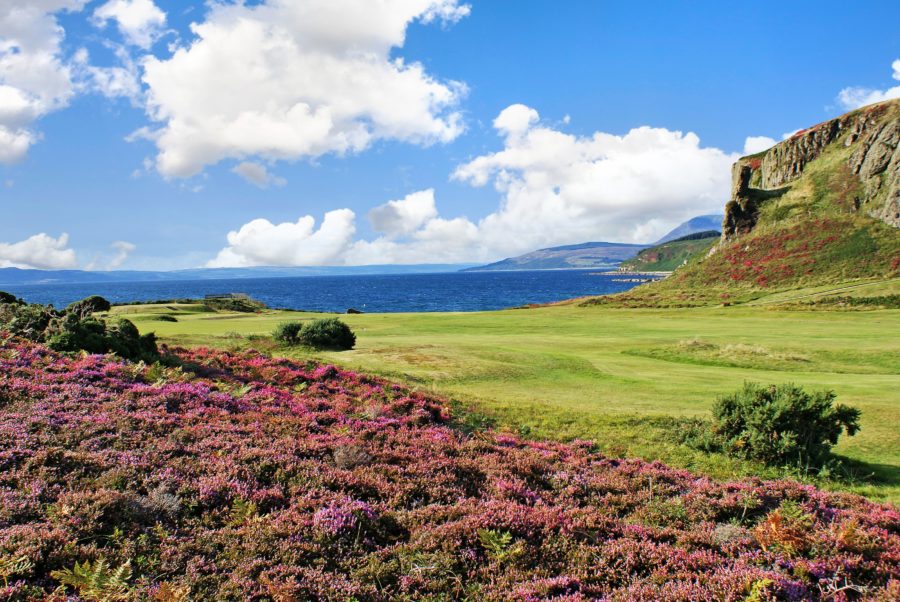
credit: Shiskine Golf Club
Even if you are not a golfer, you are going to want to see this next place. Located at the south end of the String Road near Blackwaterfoot is the Shiskine Golf Links. The name “Shiskine” is from a corruption of the Gaelic meaning “marshy place.” Much of the area was a swamp at one point, but now is used mainly as farmland. In fact, the course itself is built on what was Drumadoon Farm. The Shiskine golf links is truly unlike any links course in Scotland and some have even said there is nothing else quite like it in golf. The course started off as a nine-hole course in 1896 when former Open champion and head professional at Royal Troon, Willie Fernie, was commissioned to design it. Fernie’s original fifth and ninth holes are the only survivors of the original concept. The course was supposed to be extended to a full 18 holes but neglect during World War 1 left six of the 18 holes not suitable for play. This left Shiskine with a very unconventional 12-hole course, designed by Willie Park. Park was a Scottish professional golfer who won the Open Championship twice. Park was also a successful golf equipment maker and golf writer. In his later years, Park built a significant career as one of the world’s best golf course architects. All of this, plus its unique history, make visiting and playing Shiskine a truly unique experience.
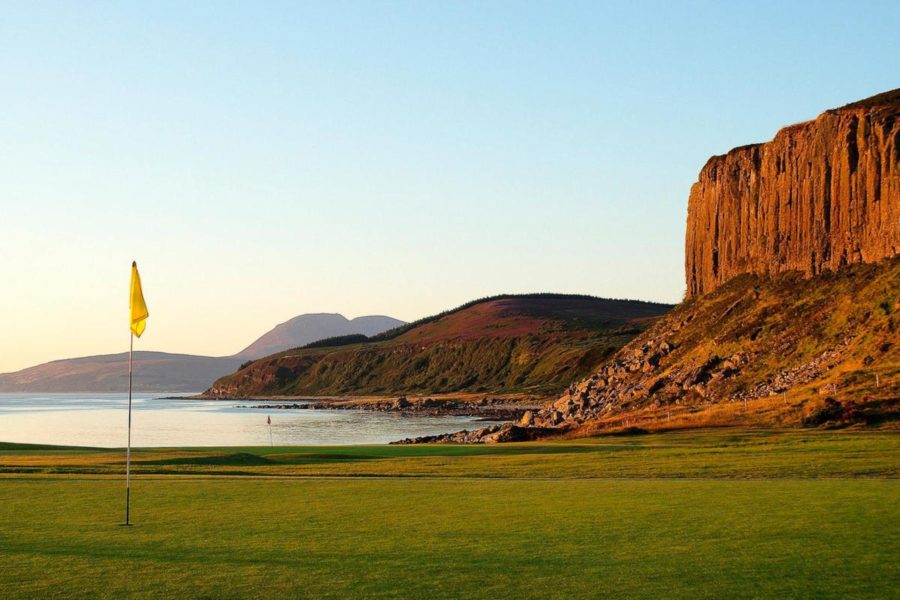
credit: VisitScotland
Almost all of the holes at Shiskine are blind and wind their way through tortuous terrain beneath the massive cliffs of Drumadoon to the craggy seas. Some say that the modern school of golf course design would cringe at some of Shiskine’s features but the course is a true shrine to the way golf used to be played in his purest form. With hole names like “Himalayas,” “Shelf,” “Hades,” and the famous “Crow’s Nest,” you can just imagine the challenges.
My dear friends from Kilmarnock, Peter and Evelyn Clark, played Shiskine for the first time in 2017 when they came over to support my Coastal Way walk. The Clarks joined me again this year on Arran and rather than try one of the six other courses on the island, they opted to return to Shiskine for yet another quirky round of golf. It is no wonder that Shiskine’s unusual links, gorgeous scenery and unpredictable weather have elevated a round here to cult status. I can knock a ball around a golf course at times, but am not a regular golfer. However, I have always appreciated good course design and have found the courses I have visited in Scotland to be some of the most scenic in the world. There is nothing quite like links golf – where golf is “played on the ground” as opposed to being “played in the air.” Links courses are characterized by undulating surfaces, sandy soil and are subject to typical seaside weather and wind. Balls need to be played so they “run up” to the holes, which can prove quite challenging. To me, there is nothing more beautiful than walking a links course especially in Scotland where the scenery and atmospheric weather never disappoint.
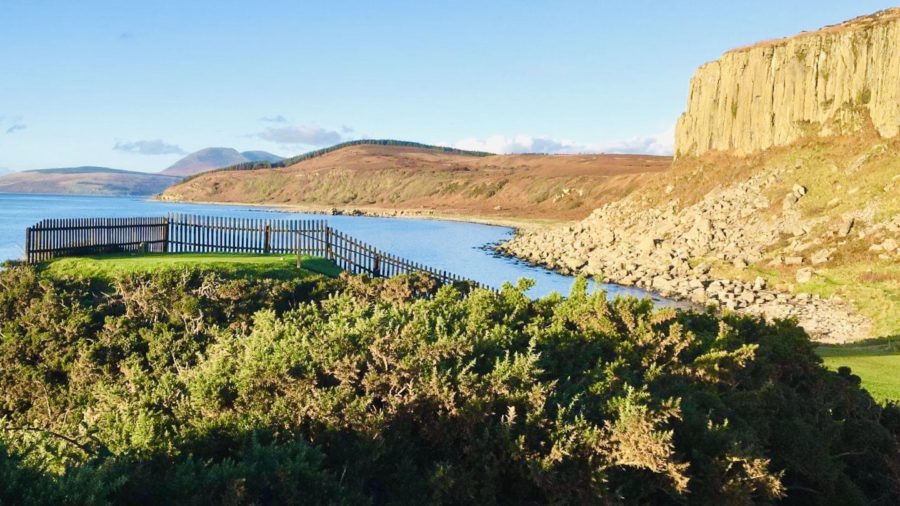
credit: Evelyn Clark
If on Arran, plan a trip to Shiskine Golf Links – to play a round or just to walk the course. The entire course can be played in 2 hours – so in a morning or afternoon – with plenty of time for more touring that day. The beauty and purity of Shiskine has placed it on Britain’s Top 100 Golf Courses for several years and as a destination on Arran, I think it’s a must see.
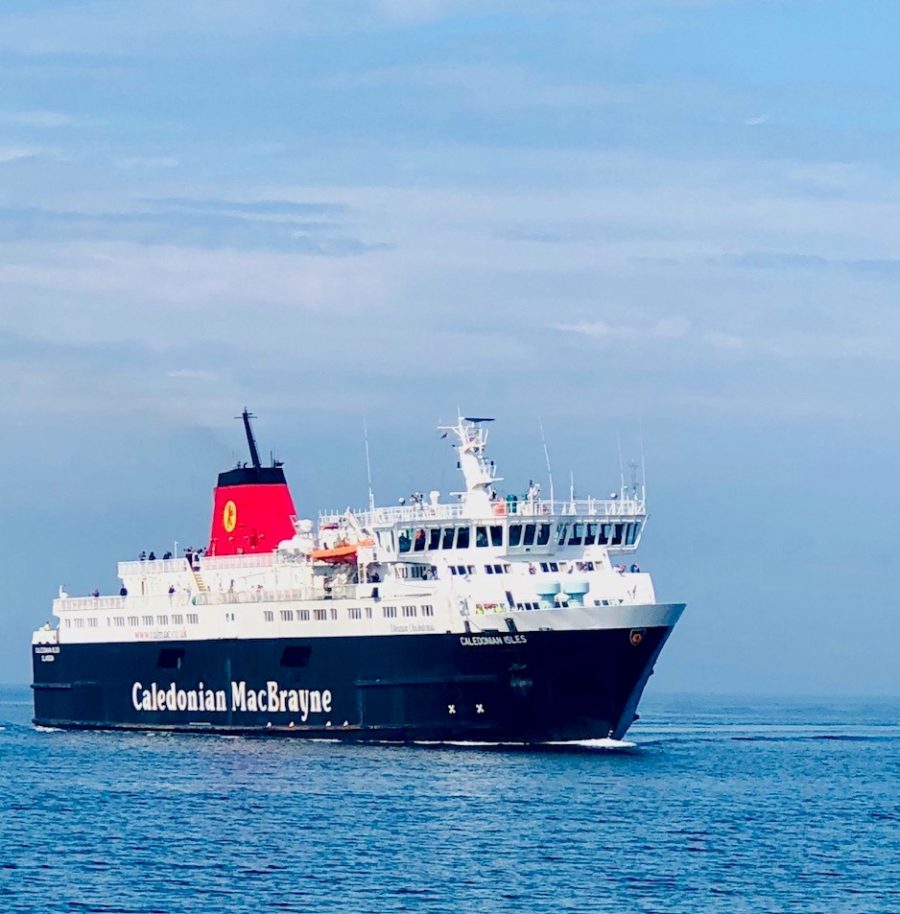
So, that’s my Top 6 list for Arran. If your time is limited, these are some of my favorites things to do on this magical little island. After four glorious days, we headed out toward the mainland on the Caledonian MacBrayne ferry with hearts full from our Arran adventures. Our destination was across the belly of Scotland to Aberdeen by car and then the overnight Northlink ferry to Lerwick, Shetland. In Part 2 of “The Scotland Diaries 2019,” I’ll be singing the praises of the Shetland Isles and their unique landscapes and culture. Stay tuned!
**Special thanks to my Arran traveling companions — Peter and Evelyn Clark, Colin Bell, Rhona Walker, Doreen and Tony Rau and — last but not least — Gary Dempster. So many laughs!**
Have you traveled to the Isle of Arran? Which Scottish Islands are on your #bucketlist?
 Anne Gavin is a senior writer at Outlander Cast and
Anne Gavin is a senior writer at Outlander Cast and obsessive frequent traveler to Scotland. Her 2016, 2017 and 2018 “The Scotland Diaries” travel series can be found at Outlander Cast by searching “Scotland Diaries.”
Follow Anne on Instagram here or at Outlander Cast’s Instagram here, where many of Anne’s photos of Scotland are often featured.


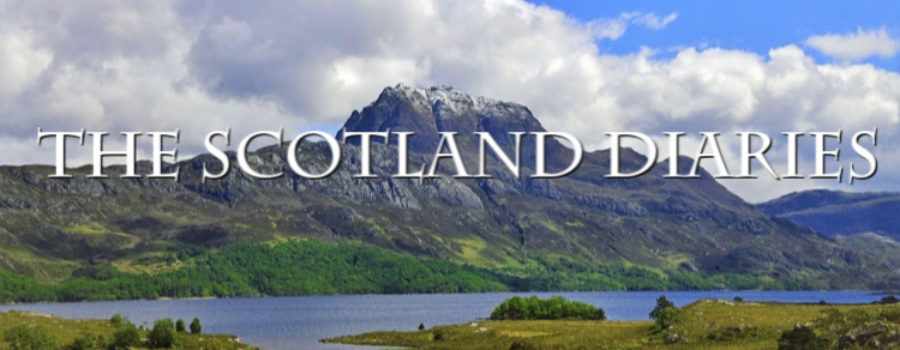



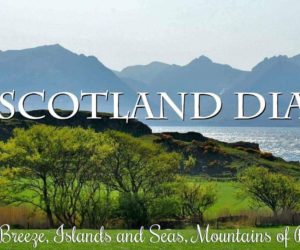







4 Comments
Leave your reply.